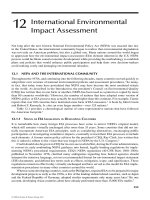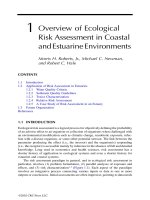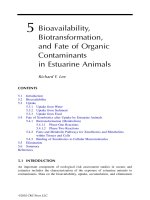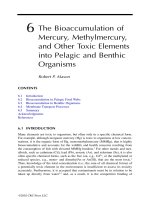Remote Sensing and GIS Accuracy Assessment - Chapter 12 ppsx
Bạn đang xem bản rút gọn của tài liệu. Xem và tải ngay bản đầy đủ của tài liệu tại đây (280.75 KB, 10 trang )
163
CHAPTER
12
An Error Matrix Approach to Fuzzy Accuracy
Assessment: The NIMA Geocover Project
Kass Green and Russell G. Congalton
CONTENTS
12.1 Introduction 163
12.2 Background 164
12.3 Methods 165
12.3.1 Classification Scheme 166
12.3.2 Sampling Design 166
12.3.3 Site Labeling 167
12.3.4 Compilation of the Deterministic and Fuzzy Error Matrix 168
12.4 Results 168
12.5 Discussion and Conclusions 170
12.6 Summary 171
References 171
Appendix A: Classification Rules 172
12.1 INTRODUCTION
As remote sensing applications have grown in complexity, so have the classification schemes
associated with these efforts. The classification scheme then becomes a very important factor
influencing the accuracy of the entire project. A review of the recent accuracy assessment literature
points out some of the limitations of using only an error matrix approach to accuracy assessment
with a complex classification scheme. Congalton and Green (1993) recommend the error matrix
as a jumping-off point for identifying sources of confusion (i.e., differences between the map
created from remotely sensed data and the reference data) and not simply the “error.” For example,
the variation in human interpretation can have a significant impact on what is considered correct.
If photographic interpretation is used as the source of the reference data and that interpretation is
not completely correct, then the results of the accuracy assessment could be very misleading. The
same holds true even for observations made in the field. As classification schemes become more
complex, more variation in human interpretation is introduced (Congalton, 1991; Congalton and
Biging, 1992; Gong and Chen, 1992; Lowell, 1992).
L1443_C12.fm Page 163 Saturday, June 5, 2004 10:33 AM
© 2004 by Taylor & Francis Group, LLC
164 REMOTE SENSING AND GIS ACCURACY ASSESSMENT
Gopal and Woodcock (1994) proposed the use of fuzzy sets to “allow for explicit recognition
of the possibility that ambiguity might exist regarding the appropriate map label for some locations
on a map. The situation of one category being exactly right and all other categories being equally
and exactly wrong often does not exist.” They allowed for a variety of responses, such as absolutely
right, good answer, acceptable, understandable but wrong, and absolutely wrong. While dealing with
the ambiguity, this approach does not allow the accuracy assessment to be reported as an error matrix.
This chapter introduces a technique using fuzzy accuracy assessment that allows for the analyst
to incorporate the variation or ambiguity in the map label and also present the results in the form
of an error matrix. This approach is applied here to a worldwide mapping effort funded by the
National Imagery and Mapping Agency (NIMA) using Landsat Thematic Mapper (TM) imagery.
The Earth Satellite Corporation (Earthsat) performed the mapping and Pacific Meridian Resources
of Space Imaging conducted the accuracy assessment. The results presented here are for one of
the initial prototype test areas (for an undisclosed location of the world) used for developing this
fuzzy accuracy assessment process.
12.2 BACKGROUND
The quantitative accuracy assessment of maps produced from remotely sensed data involves
the comparison of a map with reference information that is assumed to be correct. The purpose of
a quantitative accuracy assessment is the identification and measurement of map errors. The two
primary motivations include: (1) providing an overall assessment of the reliability of the map (Gopal
and Woodcock, 1994) and (2) understanding the nature of map errors. While more attention is often
paid to the first motivation, understanding the errors is arguably the most important aspect of
accuracy assessment. For any given map class, it is critical to know the probability of the site’s
being labeled correctly and what classes are confused with one another. Quantitative accuracy
assessment provides map users with a consistent and objective analysis of map quality and error.
Quantitative analysis is fundamental to map use; without it, users would make decisions without
knowing the reliability of the map as a whole or the sources of confusion.
The error matrix is the most widely accepted format for reporting remotely sensed data clas-
sification accuracies (Story and Congalton, 1986; Congalton, 1991). Error matrices simply compare
map data to reference data. An error matrix is an array of numbers set out in rows and columns
that expresses the number of pixels or polygons assigned to a particular category in one classification
relative to those assigned to a particular category in another classification (Table 12.1). One of the
classifications is considered to be correct (reference) and may be generated from aerial photography,
airborne video, ground observation, or ground measurement, while the other classification is
generated from the remotely sensed data (observed).
An error matrix is an effective way to represent accuracy because both the total and the individual
accuracies of each category are clearly described and confusion between classes is evident. Also
indicated are errors of inclusion (commission errors) and errors of exclusion (omission errors) that
may be present in the classification. A commission error occurs when an area is included into a
category when it does not belong. An omission error is excluding an area from the category in
which it does belong. Every error is an omission from the correct category and a commission to a
wrong category. For example, in the error matrix in Table 12.1 four areas were classified as
deciduous but the reference data showed that they were actually coniferous. Therefore, four areas
were omitted from the correct coniferous category and committed to the incorrect deciduous
category. Utilizing this information, users can ascertain the relative strengths and weaknesses of
each map class, creating a more solid basis for decision making.
Additionally, the error matrix can be used to compute overall accuracy and producer’s and
user’s accuracies (Story and Congalton, 1986). Overall accuracy is simply the sum of the major
diagonal (i.e., the correctly classified sample units) divided by the total number of sample units in
L1443_C12.fm Page 164 Saturday, June 5, 2004 10:33 AM
© 2004 by Taylor & Francis Group, LLC
AN ERROR MATRIX APPROACH TO FUZZY ACCURACY ASSESSMENT 165
the error matrix. This value is the most commonly reported accuracy assessment statistic. User’s
and producer’s accuracies are ways of representing individual category accuracies instead of just
the overall classification accuracy.
One of the assumptions of the traditional or deterministic error matrix is that an accuracy
assessment sample site can have only one label. However, classification scheme rules often impose
discrete boundaries on continuous conditions in nature. In situations where classification scheme
breaks represent artificial distinctions along a continuum of land cover (LC), observer variability
is often difficult to control and, while unavoidable, it can have profound effects on results (Congalton
and Green, 1999). While it is difficult to control observer variation, it is possible to use a fuzzy
assessment approach to compensate for differences between reference and map data that are caused
not by map error but by variation in interpretation (Gopal and Woodcock, 1994). In this study, both
deterministic error matrices and those using the fuzzy assessment approach were compiled.
12.3 METHODS
Accuracy assessment requires the development of a statistically rigorous sampling design of
the location (distribution) and type of samples to be taken or collected. Several considerations are
critical to the development of a robust design to support an accuracy assessment that is truly
representative of the map being assessed. Important design considerations include the following:
• What are the map classes and how are they distributed? How a map is sampled for accuracy will
partially be driven by how the categorical information of interest is spatially distributed. These
distributions are a function of how the features of interest have been categorized — referred to as
the “classification scheme.”
• What is the appropriate sample unit? Sampling units are the portions of the landscape that will be
sampled for the accuracy assessment.
• How many samples should be taken? Accuracy assessment requires that an adequate number of
samples be gathered so that any analysis performed is statistically valid. However, the collection
of data at each sample point can be very expensive, requiring that sample size be kept to a minimum
to be affordable.
Table 12.1
Example Error Matrix
L1443_C12.fm Page 165 Saturday, June 5, 2004 10:33 AM
© 2004 by Taylor & Francis Group, LLC
166 REMOTE SENSING AND GIS ACCURACY ASSESSMENT
• How should the samples be chosen? The choice and distribution of samples, or sampling scheme,
is an important part of any inventory design. Selection of the proper scheme is critical to generating
results that are representative of the map being assessed. First, the samples must be selected without
bias. Second, further data analysis will depend on which sampling scheme is selected. Finally, the
sampling scheme will determine the distribution of samples across the landscape, which will
significantly affect accuracy assessment costs.
This chapter addresses all of the above considerations relative to the NIMA GeoCover study.
Major study elements included (1) the finalization of the NIMA GeoCover classification scheme,
(2) accuracy assessment sample design and selection, (3) accuracy assessment site labeling, and
(4) the compilation of the deterministic and fuzzy error matrix
12.3.1 Classification Scheme
The first task in this project was to specify the NIMA GeoCover classification system rules. A
classification scheme has two critical components: (1) a set of labels (e.g., deciduous forest, urban,
shrub/scrub, etc.) and (2) a set of rules or definitions such as a dichotomous key for assigning
labels. Without a clear set of rules, the assignment of labels to types can be arbitrary and lack
consistency. In addition to having labels and a set of rules, a classification scheme should be
mutually exclusive and totally exhaustive. All study partners worked together to develop and finalize
a classification scheme with the necessary labels and rules. Table 12.2 presents the labels; the
classification rules can be found in Appendix A of this chapter.
12.3.2 Sampling Design
Sample design often requires trade-offs between the need for statistical rigor and the practical
constraints of budget and available reference data. To achieve statistically reliable results and keep
costs to a minimum, a multistaged, stratified random sample design was employed for this project.
Research by Congalton (1988) indicates that random and stratified random samplings are the optimal
sampling designs for accuracy assessment.
One of the most important aspects of sample design is that the reference data must be inde-
pendent from data used to create the map. The need for independence posed a dilemma for the
assessment of the NIMA GeoCover prototype because the National Technical Means (NTM) used
for reference data development were not available for the entire study area. NTM can be defined
as classified intelligence gathering systems and the data they generate.
As a result of this limited NTM availability, a choice needed to be made to either (1) constrain
the accuracy assessment sample to the areas with existing NTM data, and thereby risk sampling
Table 12.2
Classification Labels
Class Number Class Name
1 Forest, Deciduous
2 Forest, Evergreen
3 Shrub/Scrub
4 Grassland
5 Barren/Sparsely Vegetated
6 Urban/Built-Up
7 Agriculture, Other
8 Agriculture, Rice
9 Wetland, Permanent Herbaceous
10 Wetland, Mangrove
11 Water
12 Ice/Snow
13 Cloud/Cloud Shadow/No Data
L1443_C12.fm Page 166 Saturday, June 5, 2004 10:33 AM
© 2004 by Taylor & Francis Group, LLC
AN ERROR MATRIX APPROACH TO FUZZY ACCURACY ASSESSMENT 167
only some of the mapped area, or (2) allow samples to be chosen randomly, resulting in some
samples landing in areas where existing NTM was not immediately available for reference data
development. The latter approach was selected because limiting the accuracy assessment area was
considered statistically unacceptable. To overcome the NTM data gaps, first-stage samples were
chosen prior to receipt of the final map. This provided additional time for the acquisition of new
NTM data. Persistent data gaps were supplemented by the interpretation of TM composite images.
First stage sample units were 15-min quadrangle areas. To ensure that an adequate number of
accuracy assessment sites per cover class were sampled, quadrangles were selected for inclusion
in accuracy assessment based on the diversity and number of cover classes in the quadrangle. A
relative diversity index was determined through the screening of TM composite images of the study
area. The number and diversity of cover type polygons were summarized for each quadrangle, and
the six quadrangles with the greatest cover type diversity and largest number of classes were selected
as the first-stage samples.
The second-stage sample units were the polygons of the LC map vector file. Fifty polygons
per class were randomly selected across all the six quadrangles. If fewer than 50 polygons of a
particular class existed within the six quadrangles, then all the available polygons in that class were
selected. Both primary and secondary sample selection was automated using accuracy assessment
software developed for this project.
12.3.3 Site Labeling
All accuracy assessment samples had two class labels: a map label and a reference site label.
For this project, the “map” label was automatically derived from the LC polygon map label provided
by Earthsat and stored for later use in the compilation of the error matrix. An expert analyst, based
on image interpretation of NTM data, manually assigned the corresponding “reference” label. Each
sample polygon was automatically displayed on the computer screen simultaneously with the
assessment data form (Figure 12.1). The analyst entered the label for the site into the form using
the imagery and other ancillary data available. To ensure independence, at no time did the image
analyst labeling the samples have access to map data.
To account for variation in interpretation, the accuracy assessment analyst also completed a
LC-type fuzzy logic matrix for every accuracy assessment site (Figure 12.1). Each polygon was
evaluated for the likelihood of being identified as each of the possible cover types. First, the analyst
Figure 12.1
Form for labeling accuracy assessment reference sites.
L1443_C12.fm Page 167 Saturday, June 5, 2004 10:33 AM
© 2004 by Taylor & Francis Group, LLC
168 REMOTE SENSING AND GIS ACCURACY ASSESSMENT
determined the most appropriate label for the site, and the label was entered in the appropriate box
under the “classification” column in the form. This label determined in which row of the matrix
the site would be tallied and was used for calculation of the deterministic error matrix. After
assigning the label for the site, the remaining possible map labels were evaluated as “good,”
“acceptable,” or “poor” candidates for the site’s label. For example, a site might fall near the
classification scheme margin between forest and shrub/scrub. In this instance, the analyst might
rate forest as most appropriate but shrub/scrub as “acceptable.” As each site was interpreted, the
deterministic and fuzzy assessment reference labels were entered into the accuracy assessment
software for creation of the error matrix.
12.3.4 Compilation of the Deterministic and Fuzzy Error Matrix
Following reference site labeling, the error matrix was automatically compiled in the accuracy
assessment software. Each accuracy assessment site was tallied in the matrix in the column (based
on the map label) and row (based on the most appropriate reference label). The deterministic (i.e.,
traditional) overall accuracy was calculated by dividing the total of the diagonal by the total number
of accuracy assessment sites. The producer’s and user’s accuracies were calculated by dividing the
number of sites in the diagonal by the total number of references (producer’s accuracy) or maps
(user’s accuracy) for each class. That is, from a map producer’s viewpoint, given the total number
of accuracy assessment sites for a particular class, what was the proportion of sites correctly mapped?
Conversely, class accuracy by column represents “user’s” class accuracy. For a particular class on
the map, user’s class accuracy estimates the percentage of times the class was mapped correctly.
Nondiagonal cells in the matrix contain two tallies, which can be used to distinguish class labels
that are uncertain or that fall on class margins from class labels that are most probably in error.
The first number represents those sites in which the map label matched a “good” or “acceptable”
reference label in the fuzzy assessment (Table 12.3). Therefore, even though the label was not
considered the most appropriate, it was considered acceptable given the fuzziness of the classifi-
cation system and the minimal quality of some of the reference data. These sites are considered a
“match” for estimating fuzzy assessment accuracy. The second number in the cell represents those
sites where the map label was considered poor (i.e., an error).
The fuzzy assessment overall accuracy was estimated as the percentage of sites where the “best,”
“good,” or “acceptable” reference label(s) matched the map label. Individual class accuracy was
estimated by summing the number of matches for that class’s row or column divided by the row
or column total. Class accuracy by row represents “producer’s” class accuracy.
12.4 RESULTS
Table 12.3 reports both the deterministic and fuzzy assessment accuracies. The overall and
individual class accuracies and the Kappa statistic are displayed. Overall accuracy is estimated in
a deterministic way by summing the diagonal and dividing by the total number of sites. For this
matrix, overall deterministic accuracy would be estimated at 48.6% (151/311). However, this
approach ignores any variation in the interpretation of reference data and the inherent fuzziness at
class boundaries. Including the “good” and “acceptable” ratings, overall accuracy is estimated at
74% (230/311). The large difference between these two estimates reflects the difficulty in distin-
guishing several of the classes, both from TM imagery and from the NTM. For example, a total
of 31 sites were labeled as evergreen forest on the map and deciduous forest in the reference data.
However, 24 of those sites were labeled as acceptable, meaning they were either at or near the
class break or were inseparable from the TM and/or NTM data (Appendix A).
The Kappa statistic was 0.37. The Kappa statistic adjusts the estimate of overall accuracy for
the accuracy expected from a purely random assignment of map labels and is useful for comparing
L1443_C12.fm Page 168 Saturday, June 5, 2004 10:33 AM
© 2004 by Taylor & Francis Group, LLC
AN ERROR MATRIX APPROACH TO FUZZY ACCURACY ASSESSMENT 169
Table 12.3
Error Matrix for the Initial Prototype Area Showing the Computations for the Deterministic and Fuzzy Assessments
Initial Prototype Area
MAP
Producer's Accuracies
LABELS Decid. EG Scrub/ Barren/ Ice/ Ag. Ag.
Wet,
Perm.
Cloud/
Deterministic
Totals
Percent
Deterministic
%
Fuzzy
R Forest Forest Shrub Grass Sparse Urban Snow Other Rice Herb.
Man-
grove
Water Shadow
E Deciduous Forest 48 24,7 0,1 0,3 0,0 0,1 0,0 0,11 0,0 0,0 0,0 0,18 0,0 48/113 42.5% 72/113 63.7%
F Evergreen Forest 4,0 17 0,1 0,0 0,0 0,0 0,0 0,1 0,0 0,0 0,0 0,3 0,0 17/26 65.4% 21/26 80.8%
E Shrub/Scrub 2,0 0,1 15 8,1 0,0 0,0 0,0 2,2 0,0 0,0 0,0 0,0 0,0 15/31 48.4% 27/31 87.1%
R Grassland 0,1 0,0 5,1 14 0,0 0,0 0,0 3,0 0,0 0,0 0,0 0,0 0,0 14/24 58.3% 22/24 91.7%
E Barren/Sparse Veg 0,0 0,0 0,2 0,0 0 0,0 0,0 0,1 0,0 0,0 0,0 0,0 0,0 0/3 0.0% 0/3 0.0%
N Urban 0,0 0,0 0,0 0,0 0,0 20 0,0 2,0 0,0 0,0 0,0 0,0 0,0 20/22 90.9% 22/22 100.0%
C Ice/Snow 0,0 0,0 0,0 0,0 0,0 0,0 0 0,0 0,0 0,0 0,0 0,0 0,0 NA NA NA NA
E Agriculture Other 0,1 0,1 7,15 18,6 0,0 2,0 0,0 29 0,0 0,0 0,0 1,2 0,0 29/82 35.4% 57/82 69.5%
Agriculture Rice 0,0 0,0 0,0 0,0 0,0 0,0 0,0 0,0 0 0,0 0,0 0,0 0,0 NA NA NA NA
D Wet, Perm.Herb. 0,0 0,0 0,0 0,0 0,0 0,1 0,0 0,0 0,0 0 0,0 1,0 0,0 0/2 0.0% 1/2 50.0%
A Mangrove 0,0 0,0 0,0 0,0 0,0 0,0 0,0 0,0 0,0 0,0 0 0,0 0,0 NA NA NA NA
T Water 0,0 0,0 0,0 0,0 0,0 0,0 0,0 0,0 0,0 0,0 0,0 8 0,0 8/8 100.0% 8/8 100.0%
A Cloud/Shadow 0,0 0,0 0,0 0,0 0,0 0,0 0,0 0,0 0,0 0,0 0,0 0,0 0NA NA NA NA
User's Accuracies
Totals Deterministic 48/56 17/50 15/47 14/50
NA
20/24 NA 29/51 NA NA NA 8/33 NA
Overall Accuracies
Percent Det. 85.7% 34.0% 31.9% 28.0%
NA
83.3% NA 56.9% NA NA NA 24.2% NA
Deterministic Fuzzy
Fuzzy Totals 54/56 41/50 27/47 40/50
NA
22/24 NA 36/51 NA NA NA 10/33 NA
151/311 48.6% 230/311 74.0%
Percent Fuzzy 96.4% 82.0% 57.4% 80.0%
NA
91.7% NA 70.6% NA NA NA 30.3% NA
Kappa: 37.2
Fuzzy
Totals
L1443_C12.fm Page 169 Saturday, June 5, 2004 10:33 AM
© 2004 by Taylor & Francis Group, LLC
170 REMOTE SENSING AND GIS ACCURACY ASSESSMENT
different matrices. However, it does not account for fuzzy class membership and variation in
interpretation of the reference data. From a map user’s perspective, individual fuzzy assessment
class accuracies vary from 30% (for water) to 96% (for deciduous forest). Producer’s accuracies
range from 0% (for barren/sparse vegetation and wet, permanent herbaceous) to 100% (for water
and urban). The highest combined user’s and producer’s accuracies occur in the urban class (100%
and 91.7%, respectively).
A useful comparison is the total number of sites for a particular class by row and by column.
For example, for deciduous forest there are a total of 113 reference sites and a total of 56 map
sites. This indicates that the map underestimates deciduous forest. Another underestimated class is
agriculture–other (51 vs. 82). Conversely, for evergreen forest there are a total of 50 map sites and
26 reference sites, indicating that the map overestimates evergreen forest. Other overestimated
classes include shrub (47 vs. 31) and grassland (50 vs. 24).
12.5 DISCUSSION AND CONCLUSIONS
The following text discusses and analyzes the major sources of confusion and agreement in the
LC map for the initial prototype study. The highest user’s accuracy occurs in the deciduous forest
class (96.4%). However, producer’s accuracy in deciduous forest is low (63.7%), indicating that
there is more deciduous forest in the area than is indicated on the map. The highest producer’s
accuracy is in water and urban (100%). While the urban user’s accuracy is also high (91.7%)
(indicating that urban is a very reliable class), the user’s accuracy for water is low (30.3%),
indicating that significant commission errors may exist in the water class. For example, 18 water
map sites were determined to be deciduous in the reference data. After the matrix was generated,
these sites were reviewed. In each case, the sites were small, scattered polygons in forested areas.
Because the water was maintained at full resolution (no filtering was performed), any scattered
pixels of water were maintained in the polygon coverage. Many of these polygons came from one
or two pixels of water. Because there are many of these small polygons, more than half of the
accuracy assessment sites for water came from these polygons.
Confusion also existed in the agriculture–other class, which tends to be confused with
shrub/scrub, grassland, or deciduous forest. User’s class accuracy for agriculture–other is estimated
at 71% (36/51). Eleven sites were labeled as deciduous forest. These sites were also reexamined.
In most all cases, the polygons came from small groups of pixels (greater than the minimum
mapping unit of 1.4 ha) labeled as agriculture within forested areas. The matrix also identifies
confusion between agriculture and shrub and between agriculture and grasslands. For the
shrub/scrub map class, 22 sites were labeled as agriculture in the reference data, with 15 sites rated
as “poor.” Subsequent review of the maps revealed scattered pixels and polygons of shrub within
agricultural areas and scattered agriculture within shrub. For grasslands, 24 sites were labeled as
agriculture in the reference data, with 18 sites labeled as “acceptable.” This reflects the uncertainty
with separating grassland from agriculture in many cases. Often, they have identical spectral
responses, and unless there are distinct geometric spatial patterns or other contextual features, it is
very difficult to distinguish these classes from TM imagery alone.
Map error is often the result of scattered polygons in otherwise homogeneous areas. For
example, scattered small polygons of water (particularly in forested areas) accounted for the low
estimate of class accuracy for water. Likewise, scattered polygons of agriculture in shrub and
grassland and scattered polygons of shrub and grassland in agriculture influenced the accuracies
of these classes. This type of error points to the need for increased precision in the image classi-
fication algorithms, additional map editing, and/or refinement of the polygon-generating algorithms.
Finally, it should be noted that the first-stage sample units contained no polygons of bar-
ren/sparse vegetation, agriculture–rice, ice/snow, mangrove, cloud/shadow or wet, permanent her-
baceous. Therefore, these map classes were not sampled for accuracy assessment. Because the first-
L1443_C12.fm Page 170 Saturday, June 5, 2004 10:33 AM
© 2004 by Taylor & Francis Group, LLC
AN ERROR MATRIX APPROACH TO FUZZY ACCURACY ASSESSMENT 171
stage samples are chosen for their diversity, this indicates that the entire map also has no or few
polygons with these classes. Considering the location of the prototype, it is reasonable to assume
that ice/snow, agriculture–rice, and mangrove do not exist in the area. However, a few reference
sites (
n
= 5) were labeled barren/sparse vegetation and wet, permanent herbaceous, indicating that
these classes do exist in the area and may be underrepresented in the map.
12.6 SUMMARY
The error matrix or contingency table has become widely accepted as the standard method for
reporting the accuracy of GIS data layers derived from remotely sensed data. The matrix provides
descriptive statistics including overall, producer’s, and user’s accuracies as well as sample size
information by category and in total. In addition, the matrix is a starting point for a variety of
analytical tools, including normalization and Kappa analysis. More recently, the incorporation of
fuzzy accuracy assessment has been suggested and adopted by many remote sensing analysts. As
proposed, most of these current techniques use a variety of metrics to represent the fuzzy analysis.
This chapter introduces the use of a fuzzy error matrix for applying fuzzy accuracy assessment.
The fuzzy matrix has the same benefits as a traditional deterministic error matrix, including the
computation of all the descriptive statistics. A detailed, practical case study is presented to dem-
onstrate the application of this fuzzy error matrix.
A total of 311 accuracy assessment sites were utilized to estimate the accuracy of the initial
prototype area. The traditional estimate of overall accuracy is 48.6%. Accounting for fuzzy class
membership and variation in interpretation, overall accuracy is estimated at 74%. The spread
between the deterministic and fuzzy assessment estimates is large, but not unusual. Part of this
spread is a function of the lack of NTM for several of the reference sites (
n
= 84), resulting in the
reference label’s being determined from manual interpretation of the TM data. Hopefully, more
NTM will be available as the project progresses, which will reduce the spread between deterministic
and fuzzy logic estimates. However, some spread will remain because of fuzziness in the boundaries
of LC classes. Therefore, acceptable fuzziness between deciduous and evergreen forest (especially
in mixed conditions) and deciduous forest and shrub will remain.
REFERENCES
Congalton, R., A comparison of sampling schemes used in generating error matrices for assessing the accuracy
of maps generated from remotely sensed data,
Photogram. Eng. Remote Sens.
, 54, 587–592, 1988.
Congalton, R., A review of assessing the accuracy of classifications of remotely sensed data,
Remote Sens.
Environ.
, 37, 35–46, 1991.
Congalton, R. and G. Biging, A pilot study evaluating ground reference data collection efforts for use in forest
inventory,
Photogram. Eng. Remote Sens.,
58, 1669–1671, 1992.
Congalton R. and K. Green, A practical look at the sources of confusion in error matrix generation,
Photogram.
Eng. Remote Sens.,
59, 641–644, 1993.
Congalton, R. and K. Green,
Assessing the Accuracy of Remotely Sensed Data: Principles and Practices,
Lewis Publishers, Chelsea, MI, 1999.
Gong, P. and J. Chen, Boundary Uncertainties in Digitized Maps: Some Possible Determination Methods, in
Proceedings of GIS/LIS’92, San Jose, CA, 1992, pp. 274–281.
Gopal, S. and C. Woodcock, Theory and methods for accuracy assessment of thematic maps using fuzzy sets,
Photogram. Eng. Remote Sens.
, 60, 181–188, 1994.
Lowell, K., On the Incorporation of Uncertainty into Spatial Data Systems
,
in
Proceedings of GIS/LIS’92
,
San Jose, CA, 1992, pp. 484–493.
Story, M. and R. Congalton, Accuracy assessment: a user’s perspective,
Photogram. Eng. Remote Sens.,
52,
397–399, 1986.
L1443_C12.fm Page 171 Saturday, June 5, 2004 10:33 AM
© 2004 by Taylor & Francis Group, LLC
172 REMOTE SENSING AND GIS ACCURACY ASSESSMENT
APPENDIX
A
Classification Rules
Parcel Appearance Categorization Call
If pixel appears as water Water
(Category 11)
If
≥
35% man-made impervious material Urban
(Category 6)
If cultivated (excluding forest plantations) Examine for evidence of rice cultivation
If rice Agriculture, Rice
(Category 8)
Otherwise Agriculture, Other
(Category 7)
If total natural vegetation cover
≥
10% Examine for content
If coastal/estuarine AND vegetation cover is mangrove Wetland, Mangrove
(Category 10)
If
≥
35% woody vegetation AND > 3 m in height Examine for forest type
If woody vegetation deciduous w/ < 25% evergreen
intermixture
Forest, Deciduous
(Category 1)
If woody vegetation deciduous w/
≥
25% evergreen
intermixture OR if woody vegetation is 100% evergreen
Forest, Evergreen
(Category 2)
If woody vegetation
≥
10% cover AND height < 3 m OR if
woody vegetation between 10% and 35% cover at any
height
Shrub/Scrub
(Category 3)
If herbaceous cover
≥
10% OR mixed shrub and grass AND
no evidence of seasonal or permanent saturation (topo
position = upland)
Grassland
(Category 4)
Else Wetland, Permanent Herbaceous
(Category 9)
If nonvegetated Examine for content
If soil intermittently or permanently saturated Wetland, Permanent Herbaceous
(Category 9)
If snow or ice cover Perennial Ice or Snow
(Category 12)
If view of ground obscured by cloud, shadow, satellite sensor
artifact, or lack of TM data
Cloud/Cloud Shadow/No Data
(Category 13)
Else Barren/Sparsely Vegetated
(Category 5)
L1443_C12.fm Page 172 Saturday, June 5, 2004 10:33 AM
© 2004 by Taylor & Francis Group, LLC









